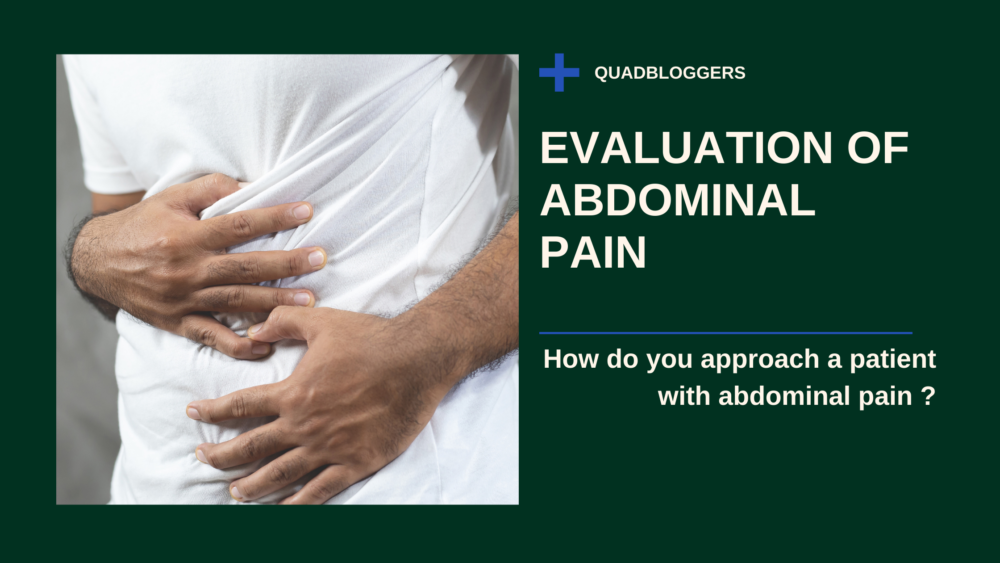Evaluation of abdominal pain, a topic that needs clear understanding about the entire abdomen and how you can keep yourself healthy.
Abdominal pain, a condition that ranges from acute to chronic life threatening emergencies due to a functional disease and disorders of various organs that generates pain in the abdomen.

How do you approach a patient with abdominal pain ?
1) History :
- The most important part of getting to know a patient is by detailed history.
- Additionally, Critical history is adequate
- Duration and pattern:
- Duration and pattern describes the severity and hence, nature of the pain
- Type and location:
- This usually provides the nature of the pain all in all
- Pain associated with internal organs:
- Usually occurs in the midline
- Meanwhile, Localization is poor
- Abdominal pain may be crampy
- Colon pain ( longest part of large intestine )hence is usually felt in the lowest and median part of abdomen.
- Biliary pain ( pain in the abdomen, usually due to cyst or stone obstruction ) results in discomfort pain
- Somatic pain ( pain from muscles, tendons and simultaneously skeletal structure ) is sharper and is associated with disease and increases with movement.
2) Factors that relieve pain:
Ask about its relationship to:
- Eating habits
- Defecation
- Urination
- Position
- Medication
- Menstrual cycle
- Stress
3) Symptoms:
Look for the following associated symptoms
- Weight loss: In cases of tumors, malabsorption and blood flow issues all in all.
- Fever and chills: Indicating an infection, heart related issues or swelling accordingly
- Nausea, vomiting
- Gastritis
- Additionally, Difficulty in swallowing
- Constipation or inability to poop
- Diarrhea
- Jaundice
- Painful urination
- Disorders of skin, joints
4) Physical examination( Evaluation of abdominal pain ):
- Evaluate the abdomen as to the reason behind the pain accordingly
- Furthermore, Look for any abdominal distention, fluid or air accumulation
- Pain felt other the site of location
- Altered bowel sounds
- Presence of hernias
- Meanwhile, Check if the liver or spleen size has changed
- Additionally, Rectal examination done to check for location, site of pain and if any mass is present
- Examination of pelvis in women is vital all in all.
5) General examination:
- Look for any nutritional deficiency accordingly
- Electrolyte imbalance
- Liver disease
- Arterial disease
- Lesions of skin
- Cardiac issues
6) Investigations in evaluation of abdominal pain:
- Complete blood count
- Serum electrolytes
- Serum glucose
- Liver function test
- Renal or kidney function test
- Chest x ray simultaneously to determine diseases involving the lungs, heart, pleura and mediastinum
- Furthermore, ECG to rule out cardiac pain
- Abdominal radiographs, meanwhile to evaluate gas pattern, liver size, bowel displacement and abdominal distention.
- Ultrasonography abdomen simultaneously for complete visualization of the abdomen
- CT scan hence to look for masses, abscess and aneurysm ( enlargement of arteries ).
- Gastrointestinal endoscopy
- Colonoscopy
- Biopsy
- Laparoscopy
7) General treatment:
- Proton pump inhibitors, all in all
- Pan D containing pantoprazole and domperidone, before food for gastritis, burning sensation
- Mucaine gel syrup simultaneously for chest burn and gastritis related issues
8) Causes of abdominal pain:
A) Pain that starts from the abdomen:
- Stomach lining inflammation
- Bacterial contamination
- Ulcer
- Inflammation of pancreas
- Trauma
- Typhoid fever
- Appendicitis
B) Metabolic causes:
- Diabetes
- Increased fat
- Fever
C) Pain originating away from abdomen:
- Pneumonia
- Heart attack
- Heart failure
- Myocarditis- inflammation of heart muscle
- Empyema-collection of pus between the lungs
- Esophageal disease, all in all
D) Psychiatric causes:
- Psychiatric disorders
- Herpes zoster
- Spinal cord compression
Additionally, For more such blogs, click here
Furthermore, To get a detailed description of the diseases please refer: Harrison manual of internal medicine

